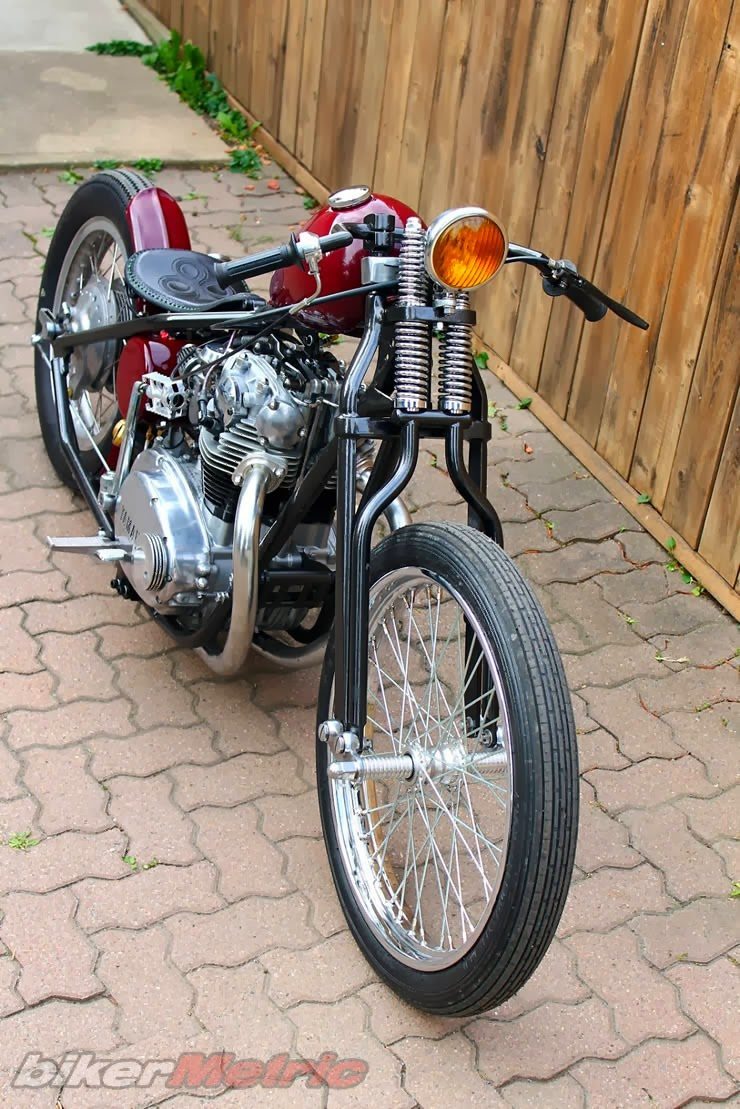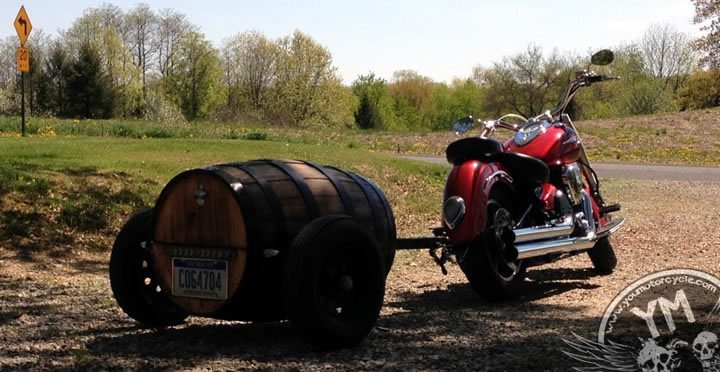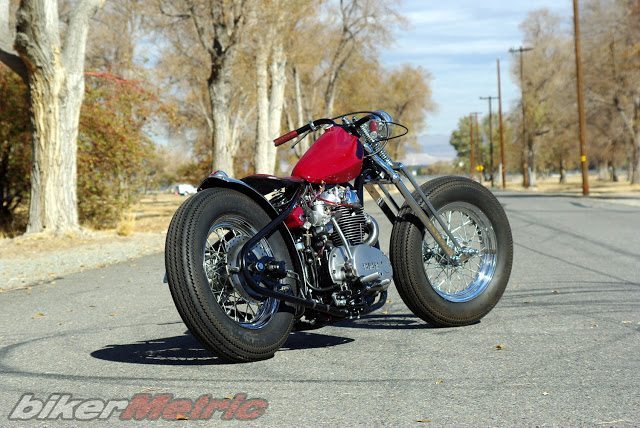it’s been a long time coming but here it is…. a techTip!
once, i was a man who thought he knew some sh*t. i was a man who knew who to trust, who to fight for, who to believe, who to fight against. i was a man who ate cheese from a pitchfork, drank so much beer a shark would wince after chomping off my arm, who professed to dream as you do; to create machines of glorious fun for as inexpensively as possible. life and limb be damned.
then i met hugh owings. he has a shop in asheville. he drinks both great and sh*tty beer. he has a generous smile and a wife who reflects the same. they made us feel most welcome when we visited this summer and invited us to stay with them any time. suckers. *** bless their hearts.
if you like this article, please comment below and share this post with all you know. these are (mostly) hugh’s words. these are his photos. this is his knowledge. that is his pink drop cloth:
Well gang, it’s time to look into the soul of your XS650. No, I’m not talking about your Sportster tank or that TC Bros tail and apes, those are merely makeup on what might be a super hot chick under that emo mess, but, without getting down and dirty with your engine, looking cool ain’t doing you much good. Let’s face it, the newest XS650 on the road is 27 years old now, and if you got an early model XS, you are pushing 40 years. I know Jappers have that “live forever with no maintenance” reputation, but when you are dealing with bikes that have been dragged out of sheds, swamps, barns and fields, you are bound to have some problems. Just like old Triumphs, all the power and reliability in an XS650 engine starts with the crank, and also like Triumphs, the XS650 crank and bottom end are usually the most neglected part of a build. I’m not going to show you how to tear down your engine, buy a Clymers manual for that because you are building a bike for *** sakes, and it can’t hurt to maybe flip through a few pages instead of hitting Google every time you need something.
Now that we’ve got that out of the way, how can you tell if your crank is any good? Well, I’ve got a few simple steps to check over, and I’m going to show you the process of re-phasing the XS650 crankshaft while we’re at it. For some companion information on re-phasing, visit hughshandbuilt.blogspot.com/2011/01/re-phased-goodness.html.
First, get a decently clean work surface and toss down a few shop rags if you have to. For most of you, after you tear down your crankshaft it will look something like this:
Now you’ll want to remove the charging rotor if you haven’t already. Take a 17mm socket and if you are lucky enough to have an impact gun, use it. If not, then you are probably already well versed in curse words, so no need to go into all that either. Get something to keep all your parts in because it’s going to get busy and you don’t want to lose anything.
Now you will need a special remover only if you want to save the charging rotor from further damage. If your bike is like 80% of the XS machines out there, this thing is already crapped out and is going to be another nightmare if you keep it. Not surprisingly, I have a fix for that at hughshandbuilt.blogspot.com/p/xs650-permanent-magnet-alternator.html. If you aren’t interested in buying any special tools, and don’t plan to keep the crappy stock charging system, a standard puller from the local Vatozone will work fine. Either way, get that sucker off of there.
See all that **** that came out of the stator? Thats a good sign it would have left you sitting on the side of the road, far far away from home (or anyone who cares to come get you, trust me…)
Okay, now that you’ve gotten that out of the way, let’s actually get to the crank itself. Find a cheap ruler, something with metric measurements – that’s the superior system of measurement by the way – and position the rods over the ruler like so:
Wiggle the small end of the rod side to side over the ruler. You should have less than 2mm of movement. If you are right at 2mm, you are probably okay for now, but keep on reading….
Inspect the small end of the rod closely and get a flashlight if you need to. You are looking to make sure the entire ID (inner diameter) of the rod end is still coated in a copper color. If you see a lot of silver, you are at the end of your rod’s life span. If there is a small amount (less than 10%) of the total area showing silver, you are in that gray area of reuse. If you see any scoring or gouges, it’s time for new rods. Most simply put, if in doubt, get new rods.
At this point you are probably ****** off that your wallet is gonna be a bit lighter, or you are feeling pretty good about your old rods. The rods pictured here were good enough to reuse at this point. Either way, you aren’t done yet. Take a 22mm socket and remove the nut from the drive end of the crank. Pull all the parts off of that end and inspect them all for unusual wear such as cracks and pits. 99% of the time these are in good shape, but I have seen several engines that must have sat in a swamp and had that motor oil replaced with rusty water, so take your time and inspect everything carefully.
Go ahead and remove the bearings from the ends of the crank. You’ll need a set of snap-ring pliers. I recommend that since you are rebuilding the XS650 engine, do yourself a favor and do not get a set with changeable tips because they suck. You can use a clamshell bearing puller, available at most auto parts stores, or a variety of chisels to remove the bearings. If you are limited to chisels, you can wedge the chisel between the bearing and the flywheels to remove the bearings. Don’t worry, these bearings are pretty tough. Once they are off, check them closely for pits, scoring, and smooth operation. Take your time as this is the heart of your engine and once we are done, this crank will be capable of very high RPM’s if you do this right.
Now things get interesting. A lot of people would have stopped at checking the rods, but hang in there and do it right the first time. You are going to split the #2 and #3 flywheels from each other. You can use a press and wedge blocks, or take it to a shop and have it done. Any competent motorcycle repair shop should be able to do this. Don’t bother taking it to the Harley dealer your cousin works at, they haven’t quite caught on that the “V” in V-Twin stands for “Vertical.” That’s right, we’re starting a revolution and your little 650cc parallel twin is going to smoke a 96 inch vee cube like the Lords of Loud smoke crack through a crunched Keystone Light can.
Go ahead and pull the cam drive gear and all the bearings and shims.
At this point you will either have a 20T press at your disposal or you’ll head over to the local repair shop to have them do this for you. If your engine has been sitting for a good long while, spray some WD-40 or something similar on the rod bearings to get the pins lubed. You want them to slide out easily and not bind. Press out the rod pins.
Once you have the pins out, inspect them closely for any wear or pitting. You know the drill at this point. You’ll also have to inspect the large end of the rods and the roller bearings for any damage. Again, if in doubt, get new pins.
You can see some gouges in the pins which were caused by the thrust washers binding and cutting into the rod pins. This is fairly common, but these are bad enough and will be replaced. You can see in this photo the gouges circled in blue marker:
Also notice the pin in the top of the picture was galled a bit while being removed. You’ll want to replace them at this point. Luckily, you can get them for a reasonable price from mikesxs.net, along with rods if needed.
At this point, you’ve earned a good break. Take time to wrangle up a good beverage and/or grab a snack. You should have a pile of parts that look something like this:
We’ve covered a lot of parts that could cause a potential engine failure if not checked. It sucks to lose an entire engine due to a $40 bearing going bad. So pay attention.
I’m gonna show you a little bit of what I do to re-phase a crankshaft. I build about two or three of these cranks a week, and when going for high horsepower or even if just planning a Big Bore, you should build a proper crank, or have someone do it for you. If you are going with a basic rebuild with a stock bore, skip all the welding. I’ve seen plenty of stock cranks come through my shop that were very close to failing when pushed hard. Even with a basic 750 big bore kit, the crank takes a beating and will start to separate and claw its way out through the cases looking for freedom. If you’ve been having charging system problems and the rotor is crashing into the alternator housing, it’s probably a crank problem. Trent shot a short video describing that in more detail here on his YouTube channel.
When I build an engine, I expect it to handle some major abuse. Any reputable performance engine builder will weld the crank pins but I take it a step further and weld the #2 and #3 flywheel together as well. Let’s start reassembly:
Clean everything with some denatured alcohol or Acetone. You don’t want any oil on these parts or you’ll have a contaminated weld and life will suck. The bad kind of suck.
With the new rod pins pressed into the flywheels, I TIG weld them in. You cannot weld these pins properly with the bearings in place, or if you haven’t removed all the oils from the press joint. This is the reason I completely disassemble a crank and don’t just half *** it. Use your whole ***, folks.
Make sure you assemble the bearings, shims and cam gear in the proper location because once you press this together and weld it, you are committed and there is no turning back. If you are re-phasing the crank, you’ll want to relocate the cam drive gear and index the splines properly. If you’re returning to the stock configuration, then keep the two rod pins in the same plane. Press the #2 and #3 flywheels together very carefully, making sure not to bind them or bend them at all. The crank pictured in this article is being re-phased for a customer, so it will look different from stock, but all the principals are the same from here on out.
Now measure the runout on the flywheels. You should have zero runout if you’ve done this properly. If not, you may need to disassemble the flywheels and look for a bent main shaft. You’ll need a dial indicator for this and a magnetic stand. For this you can use the bottom case as a “jig.”
If everything measures properly, you can weld the splines of the #2 flywheel to the #3 flywheel. This will keep the crank from separating under high load or at high RPM.
Reassemble the thrust washers, rods and rod bearings, and press on the outer flywheels. As mentioned above, you’ll want to get the runout of the outer flywheels. Any runout at all will cause a violent vibration and can lead to cracked cases, leaky seals, and generally **** you off. Then the police come and now you’re begging friends and bail bondsmen to save your sorry ***. If you’re trying this for the first time, be prepared for it to take a few days. The very first crank I built myself took almost two weeks to complete. I thought I was going to lose my mind, and nearly gave up on my entire project. Be patient or have a professional handle the job.
Once the runout is completely dialed in, I weld the outside flywheels to the rod pins.
This crankshaft will handle just about anything you can throw at it now, and being re-phased, it will reach much higher RPM and vibrate much less. Save your genitals for banging doggy style. For those of you riding a bone stock bike, you will never understand how badly these engines vibrate in stock configuration because you are riding on about 6″ of super sweet foam. But for those of us riding on a rigid frame with about half-an-inch of seat padding, we know what it’s like to be riding along with the engine vibrating your nuts and guts out. *** forbid if you fart with the engine above 4500 RPM, you’ll think for sure you just crapped your trousers. Re-phasing gets rid of all that, but I’ll leave it to your own research to decide if it’s a mod for you.
Finally, don’t be fooled into cutting corners, whether you do it yourself or are paying to have it done; do it right the first time. You’ll be glad you did and you’ll never worry about the bottom end again.
I sign and date all my cranks – get the real deal! Maybe in 2068 everyone will be paying ridiculous amounts for a real “Hugh’s HandBuilt” crankshaft for their “period correct” XS650. Until then I think my services are quite modestly priced. As always, I’m glad to help out with your tech questions via email.
+ + +
there you go, mofos. hugh’s next techTip is already written. look for it in the next few weeks. until then, remember:

Get the best of bikerMetric directly in your inbox, once a week, every week.
 bikerMetric custom metric bobbers, choppers, and cafe racers by honda, yamaha, kawaski, and suzuki
bikerMetric custom metric bobbers, choppers, and cafe racers by honda, yamaha, kawaski, and suzuki




























Really neat. i would love to hear one running. It would have to sound, so different then stock. I am also wondering about the camshaft, and ignition. Will there be a follow up about that?
TOOLS
if folks share this and email him and buy him beer, i’m sure he’ll be glad to keep on writing one of these every month, tools. i’m hoping he will do a piece on making your own frame jig as well as finish alex’s frame series. he could also do one on building your own girder front end, and many other things…
If he is ever in Kansas City I will gladly buy him a beer. I would like to see more tec articals. Especially a frame jig. I have always just used levels, framing squares, and string. Would not know how to act with a frame jig.
TOOLS
Very informative! after reading this a couple times I have a good idea why I found a thousand pieces of briken steel inside my motor… As he says, I will not “half ***” my next motor! Thanks Hugh and thanks Trent for posting!
needing help with my 650 Yamaha flat tracker vibs like **** at high rpm also needs more power I love this motor sounds allsome on short track crank not welded yet I need to talk to someone that knows these motors well any help would be great thanks
I am investigating the rephrasing process and am most intrigued. Something I cannot wait to get my teeth into. A question crops up though, no mention of balancing is made and with that amount of welding surely this is a must.